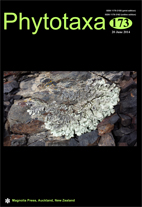Abstract
The monospecific genus Discyphus, previously considered a member of Spiranthinae (Orchidoideae: Cranichideae), displays both vegetative and floral morphological peculiarities that are out of place in that subtribe. These include a single, sessile, cordate leaf that clasps the base of the inflorescence and lies flat on the substrate, petals that are long-decurrent on the column, labellum margins free from sides of the column and a column provided with two separate, cup-shaped stigmatic areas. Because of its morphological uniqueness, the phylogenetic relationships of Discyphus have been considered obscure. In this study, we analyse nucleotide sequences of plastid and nuclear DNA under maximum parsimony and maximum likelihood criteria with the aim of clarifying its systematic position and discussing its peculiar morphology in an explicit phylogenetic context. Our analyses failed to support inclusion of Discyphus in Spiranthinae, signifying instead that this genus represents an additional isolated lineage of “core spiranthids.” The notable morphological disparity among such major lineages, as compared with the short internal branches subtending them in the molecular trees, would support the hypothesis that Discyphus represents a relict from an early radiation that also gave rise to Cranichidinae and Spiranthinae, putatively driven by adaptation to different pollinators given the morphological differences in floral morphology among these taxa.

